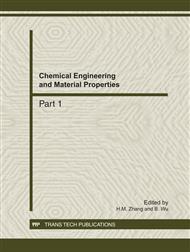p.697
p.703
p.709
p.714
p.719
p.724
p.728
p.732
p.737
Visualisation of Cornstarches Granule with Different Amylose/Amylopectin Contents: A Combined CLSM and SEM Approach
Abstract:
The morphologies and microstructures of cornstarches with different amylose/amylopectin ratios (waxy: 0/100; maize: 23/77; Gelose 50: 50/50; Gelose 80: 80/20) were studied by a combined SEM and confocal laser scanning microscope (CLSM). CLSM allowed the visualization of cross-sections of starch granules without the need for sectioning techniques that lead to destruction of the microstructure of sample. The influence of the amylose/amylopectin ratio on the internal structures and morphologies was able to be revealed by this choice of techniques. It was found that the granules of the high-amylopectin starches were more regular in shape than those of the high-amylose starches, but the surfaces of the high-amylose starches were smoother than those of the high-amylopectin starches. The high-amylose starches (G50 and G80) were brighter than that of low-amylopectin starches (waxy and maize) under confocal laser light, and the average fluorescence intensity sequence of the granules was G80>G50>maize>waxy. Waxy and maize starches show clearly cavities and channels while G50 and G80 present bright core.
Info:
Periodical:
Pages:
719-723
Citation:
Online since:
December 2011
Authors:
Keywords:
Price:
Сopyright:
© 2012 Trans Tech Publications Ltd. All Rights Reserved
Share:
Citation:


